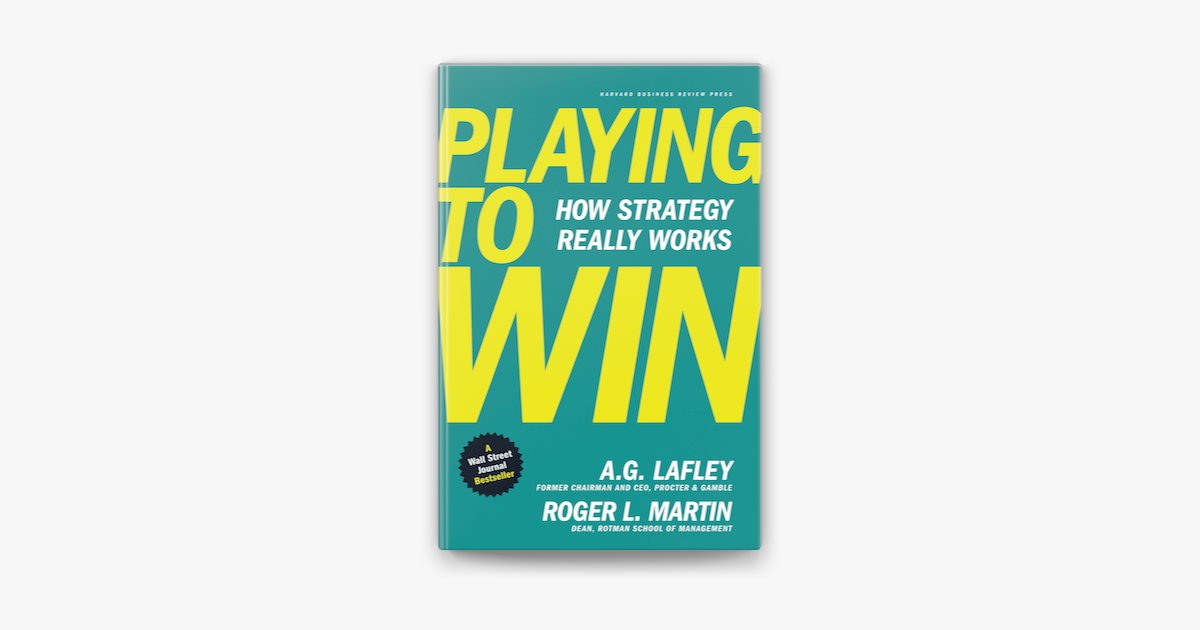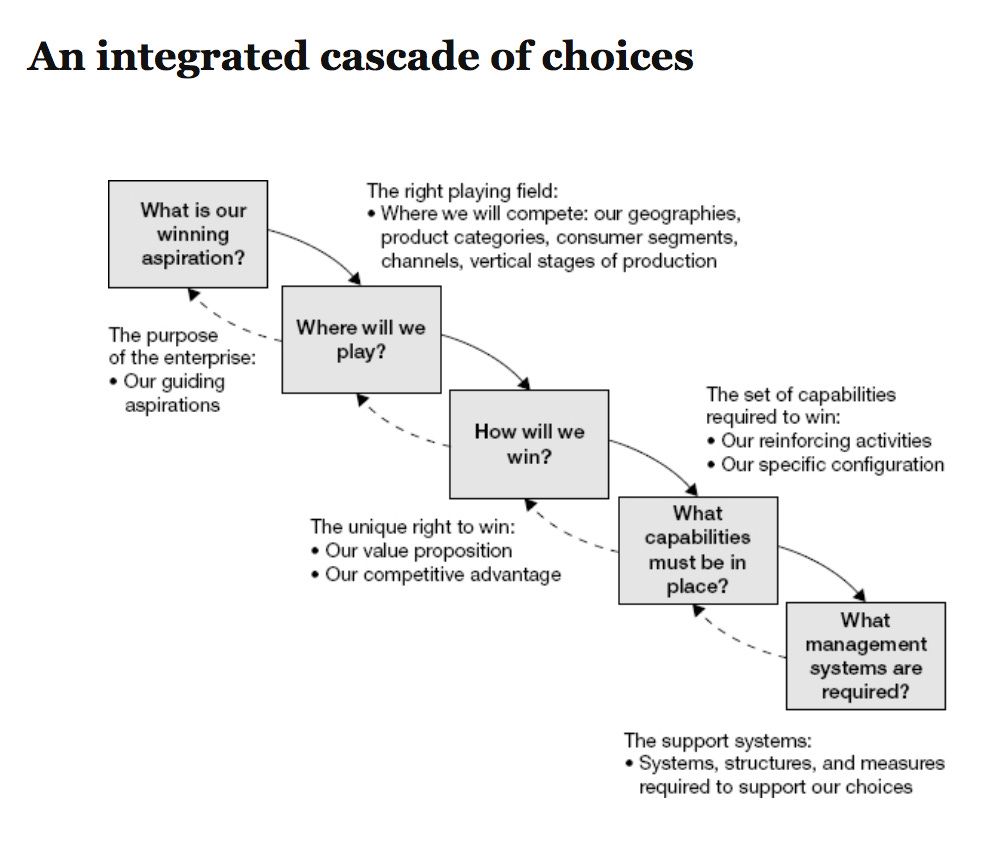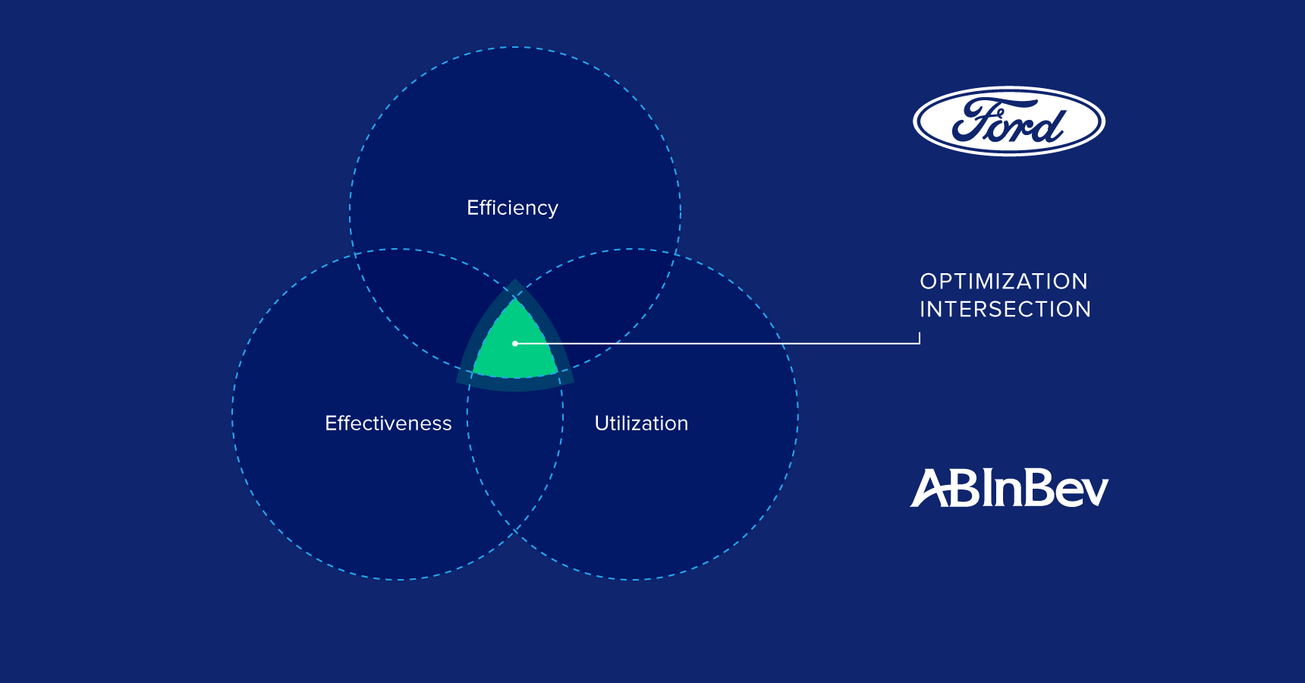Playing To Win: The Must-Read Book for Developing Winning Business Strategy
A compelling five-step framework to guide organizations in making tough strategic choices to outmaneuver the competition. This practical book provides a model for strategic thinking to transform a company's strategy and execution.

If you read only one book on strategy, read this book.
Winning in business requires making tough strategic choices, yet many companies fail to develop a coherent strategy and end up trying to be all things to all people.
In their book Playing to Win: How Strategy Really Works, former Procter & Gamble CEO A.G. Lafley and strategic advisor Roger L. Martin present a practical framework to guide organizations in making the hard trade-off decisions necessary to outmaneuver competitors.
With examples drawn from P&G and other leading companies, Lafley and Martin argue that developing successful strategy involves answering five critical questions:
- What is our winning aspiration?
- Where will we play?
- How will we win?
- What capabilities must we have?
- What management systems are required?
This review provides an in-depth summary and assessment of the key insights in Playing to Win. It analyzes the merits of the structured approach to strategy presented by the authors while also considering limitations.
Overall, the book offers an excellent model for strategic thinking that business leaders across industries should adopt in order to transform their company's strategy and execution. Managers will learn how to align their organizations from the top down and focus on making the tough choices required to drive growth and competitive advantage.
Key takeaways from the book
- Develop strategy using a structured five-step framework.
The authors present a logical process for guiding strategic thinking: identifying your winning aspiration, where you'll play, how you'll win, required capabilities, and management systems. - Make tough trade-off choices.
Companies often try to be everything to everyone, leading to lack of focus. Making hard choices about what you will and won't do is critical. - Ensure coherence across the organization.
Strategic alignment from the executive team all the way to frontline employees is key to effective execution. The entire organization must rally around the same strategy.
The Five Essential Strategic Choices

Lafley and Martin’s book, “Playing to Win: How Strategy Really Works,” puts forth the idea that developing a winning strategy initiates with five strategic choices.
These choices are:
- What is our winning aspiration?
- Where will we play?
- How will we win?
- What capabilities must be in place?
- What management systems are required?
Addressing these choices collectively can enhance your business’s competitive edge and refine the overall strategy.
The purpose of strategy is to make wise and informed decisions about your company’s future, helping to define strategy and achieve success. Implementing the Playing to Win framework creates a foundation for strategic success, driving business prosperity and paving the way for sustainable growth.
Establishing a Winning Aspiration
A winning aspiration is an inspiring statement of what success in the marketplace looks like for your company, providing a clear purpose and guiding mission in strategic terms. The establishment of a winning aspiration is pivotal, setting the foundation for an effective strategy by delineating your company’s ultimate goal and purpose.
A powerful example of a company with a winning aspiration is Procter & Gamble (P&G). Under the guidance of strategic adviser Roger Martin, P&G created an internal entity called “Global Business Services” to provide services to its business units worldwide. Filippo Passerini, the new CEO of GBS, recognized that GBS wasn’t achieving its full potential and set out to create a new strategy that would maximize value for P&G.
Identifying Your Playing Field
Determining the target market, product offerings, and distribution channels for each business unit is crucial for identifying your playing field. This process requires a thorough understanding of:
- Geography
- Product type
- Consumer segment
- Distribution channel
- Vertical stage of production
Careful assessment of both quantitative and qualitative data related to your current objectives and capabilities can help you select the best “where to play” options.
Answering key questions about:
- Potential growth markets
- High-demand product types
- Attractive consumer segments
- Natural channel choices
Our team of experts can help shape your company’s winning strategy, ensuring success and growth in the competitive market by implementing a well-crafted competitive strategy.
Mastering the Art of How to Win

Mastering the art of how to win is necessary to gain a competitive edge in your chosen market. This involves making strategic choices between differentiation or cost leadership and developing a unique value proposition. For Lafley and Martin, “winning” means achieving a sustainable competitive advantage by delivering greater value to customers than rivals, a key factor in many successful corporate turnarounds.
P&G’s success with the Gain brand is an example of mastering the art of how to win. By re-branding and improving the product to delight a passionate group of consumers who wanted a superior sensory laundry experience, P&G managed to turn Gain into a successful brand. This strategy showcases the power of understanding how to use what you have gained to help others, encouraging and motivating others to reach their goals as well.
Building Core Capabilities
Core capabilities refer to the strategic advantages that drive the success of a business. These resources, processes, and knowledge enable an organization to excel in its chosen domain. Building core capabilities involves identifying and developing key competencies and activities required to execute your chosen strategy effectively. Examples of capabilities that firms can leverage to successfully execute their strategy include branding and marketing, channel relationships and distribution networks, and industrial design and manufacturing.
While the specifics of P&G’s five core capabilities are not explicitly mentioned, it’s clear that their focus on these essential competencies has played a vital role in their strategic success. By honing in on their core capabilities, P&G has been able to drive the success of their business and maintain a competitive edge in the market.
Integrating Strategy into Company Culture

Integration of strategy into company culture is critical to embed strategic thinking into everyday decision-making. This process encourages open discussions and continuous improvement, creating an environment of success.
A.G. Lafley’s tenure as the new chief executive officer of P&G is a prime example of successfully integrating strategy into company culture. He fostered frank discussions and honest dialogue during strategy review meetings, making strategy a core part of the company’s culture.
Procter & Gamble’s transformation serves as an inspiring example of a successful implementation of integrating strategy into company culture. By making strategy an integral part of everyday actions, P&G has been able to achieve remarkable success and make a lasting impact in the market.
Lessons from Successful Corporate Turnarounds

Organizations seeking to revamp their strategies can gain valuable insights from the most successful corporate turnarounds. Companies can navigate even the most challenging situations with success by creating coherent strategies across the organization, making tough trade-off choices, and adapting the framework with flexibility.
Examining successful corporate turnarounds can provide guidance on how to effectively implement the Playing to Win framework in your own organization. Learning from these examples can enhance your understanding of the importance of a well-defined strategy and the potential benefits it can bring when applied to your business.
Creating Coherent Strategies Across the Organization
A coherent strategy is a powerful and organized approach that is clear, sensible, and aligns all its parts seamlessly. To create a coherent strategy, you should follow these essential steps:
- Craft a mission statement.
- Define objectives.
- Conduct a SWOT analysis.
- Ensure that all strategic decisions and actions are consistent and in line with the overall goals of the organization.
By following these essential elements, you can create a strategy that is cohesive and effective.
Having a coherent strategy helps guide decision-making and ensures that all efforts are focused on achieving desired outcomes. It also ensures that all departments and teams are working together towards the same goals, helping you reach success faster. Creating a coherent strategy allows your organization to stay on target with its goals and objectives, thereby achieving enduring success.
Making Tough Trade-Off Choices
Making tough trade-off choices is an important part of decision-making in any organization. Prioritizing resources and efforts to focus on the most critical aspects of the strategy can help ensure that resources are allocated effectively. Some examples of tough trade-off choices that organizations must make to achieve success include:
- Deciding between short-term gains and long-term investments
- Prioritizing customer satisfaction over cost savings
- Balancing innovation with operational efficiency
By carefully weighing these options, organizations can make informed decisions and allocate their resources in the most effective way.
Making tough trade-off choices enables organizations to prioritize their resources and efforts, focusing on the most crucial aspects of their strategy for optimal success. This can be achieved by carefully assessing both quantitative and qualitative data related to current objectives and capabilities and making deliberate decisions that embody the ambition to succeed.
Adapting the Framework with Flexibility
Adapting the framework with flexibility is paramount for staying ahead of the curve and achieving success in a dynamic and ever-changing environment. Embracing new ideas, maintaining agility in our approach, and taking calculated risks ensure that the framework remains flexible and adaptable to various situations and challenges.
Being flexible with the framework allows organizations to:
- Stay agile and responsive
- Tackle any obstacles and capitalize on opportunities
- Explore different approaches and ways of thinking, fostering cognitive flexibility and adaptability
- Encourage resilience by enabling the discovery and use of flexible strategies that can reduce risks and uncertainties.
Insights from Business Leaders and Experts

Business leaders and experts have a wealth of knowledge on the role of strategy in business success, challenges and limitations of the framework, and recommendations for applying the framework. Learning from the insights of business leaders and experts can enhance your understanding of the importance of a well-defined strategy and the potential benefits of applying the Playing to Win principles to your business.
Understanding the role of strategy in business success is crucial, as it provides a clear direction and focus for the organization. Challenges and limitations of the framework, such as its rigidity and linearity, may not always be suitable for dynamic business environments. However, by using the framework as a starting point and adapting it to suit the specific needs and context of the organization, you can achieve lasting success and make a lasting impact in the market.
The Role of Strategy in Business Success
The role of business strategy in business success is crucial, as it provides a clear direction and focus for the organization, allowing it to make informed decisions and take effective actions that are in line with its mission and vision.
Implementation of a well-defined strategy allows companies to:
- Identify their goals and objectives
- Formulate a plan to achieve them
- Stay on track with its goals and objectives while making decisions and taking actions that are aligned with its mission and vision
- Identify potential opportunities and risks
- Develop strategies to take advantage of opportunities and minimize risks
Having a clear strategic approach can help an organization in achieving its desired outcomes and ensuring long-term success.
Understanding the role of strategy in business success can enhance your ability to craft and execute strategies that drive success.
Challenges and Limitations of the Framework
The Playing to Win framework is not without its challenges and limitations. Its rigidity and linearity may not always be suitable for dynamic business environments, as it may not be able to adapt quickly to changes in the market or industry. However, it’s important to remember that the framework can still provide valuable insights and guidance for organizations looking to improve their strategies.
Recognizing and addressing these limitations enable organizations to adapt the framework to better suit their unique needs and context. This may involve using the framework as a starting point, while remaining open to new ideas and approaches, and being willing to adapt and make adjustments as necessary.
Doing so allows organizations to continue benefiting from the valuable insights and guidance of the Playing to Win framework, while preserving the flexibility necessary to succeed in today’s rapidly evolving business landscape.
Recommendations for Applying the Framework
Given the potential challenges and limitations of the Playing to Win framework, it’s important to consider how best to apply it to your organization. Recommendations for applying the framework include using it as a starting point and adapting it to suit the specific needs and context of your organization.
Some best practices for applying the framework include:
- Gaining a comprehensive understanding of your company’s goals and objectives
- Establishing a well-defined strategy
- Having a plan to measure the success of the strategy
- Staying abreast of the competitive landscape
- Being able to adapt to changing conditions
These practices will help you make the most of the framework and achieve lasting success.
Case Studies: Applying the Playing to Win Principles

The Playing to Win framework has been successfully applied by numerous companies across various industries, demonstrating its versatility and effectiveness. Examining these case studies can provide valuable insights into the best ways to apply the framework within your organization and achieve remarkable success.
Procter & Gamble’s transformation under CEO A.G. Lafley is a prime example of the successful application of the Playing to Win principles. Other successful implementations include companies such as Apple, Amazon, and Microsoft, showcasing the wide applicability of the framework in driving business success.
Procter & Gamble's Transformation
Procter & Gamble’s transformation under the leadership of CEO A.G. Lafley is a testament to the power of the Playing to Win framework. In just ten years, Lafley and strategic adviser Roger Martin managed to double P&G’s sales, quadruple its profits, and increase its market value by more than $100 billion.
By employing the Strategic Choice Cascade framework to identify and prioritize strategic choices, and then executing them effectively, Procter & Gamble was able to achieve remarkable success.
This case study, featured in the Harvard Business Review, serves as a powerful example of the potential impact of the Playing to Win principles on a struggling company, and the benefits of adopting a structured approach to strategy.
Other Successful Implementations
The Playing to Win framework has also been successfully applied by several other companies across various industries, further demonstrating its versatility and effectiveness. Companies such as Apple, Amazon, and Microsoft have used the framework to identify and prioritize strategic choices, and then implemented them to great success.
These case studies highlight the power of the Playing to Win principles in driving business success across a variety of contexts. By learning from these examples, your organization can better understand the importance of a well-defined strategy and the potential benefits of applying the framework to your own business.
The Payoff for Strategic Clarity
Lafley and Martin make a compelling case that applying the principles in Playing to Win allows companies to develop strategies that are value-creating and differentiation-building, not just value-capturing. By going through the exercise of answering the five questions, organizations end up with a strategy statement that guides coherent actions at every level, leading to winning outcomes.
While the framework is presented in a linear fashion, the authors acknowledge strategy must also be dynamic - as the competitive landscape shifts, companies need to reevaluate their choices and make necessary adjustments while staying grounded in their core strategic positioning.
The book provides a practical playbook for both small and large organizations across industries to transform their approach to strategy. While the examples focus on consumer products companies, the lessons on making trade-offs, aligning around strategic coherence, and obsessing over the details of operational execution are applicable to any company.
For any business leader searching for a model to develop a winning strategy, Playing to Win is a must-read.
It will push you to answer the hard questions required to make smart strategic choices.
By committing to this rigorous strategic thinking, your company will be well-armed to outsmart and outperform the competition.
Frequently Asked Questions
What are the steps in Playing to Win?
The five steps in Playing to Win are: 1) What is our winning aspiration? 2) Where will we play? 3) How will we win? 4) What capabilities must we have? 5) What management systems are required?
What is the play to win strategy in marketing?
The play to win strategy in marketing involves: 1) Defining your winning aspiration and target market; 2) Determining your competitive advantage and value proposition; 3) Focusing resources on the critical capabilities needed to deliver your value proposition; 4) Having supporting management systems to align your organization.
What is the story of playing to win?
Playing to Win: How Strategy Really Works, written by former P&G CEO A.G. Lafley and strategic adviser Roger Martin, outlines the strategic approach they used to double sales, quadruple profits and increase market value by over $100 billion at P&G. This successful strategy was underpinned by their cornerstone principle stressing the importance of playing to win.
What are the five essential strategic choices in the Playing to Win framework?
The essential strategic choices of the Playing to Win framework are defining a winning aspiration, identifying where to play, mastering how to win, building core capabilities, and integrating strategy into company culture and management systems.
What are some examples of companies that have successfully applied the Playing to Win principles?
Procter & Gamble, Apple, Amazon and Microsoft are some of the shining examples of businesses that have tapped into the potential of Playing to Win and achieved amazing success.
